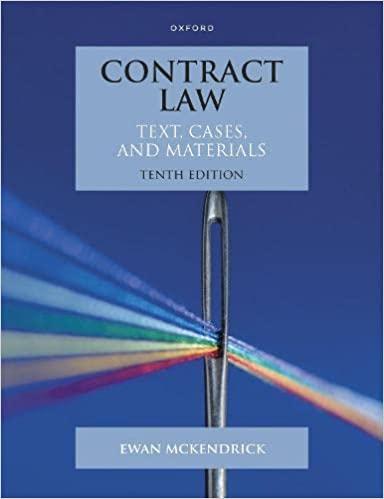Question
Shannon Johnstone has been working as an electrician for 5 years and is registered in Queensland as an electrical fitter and mechanic. Shannon has also
Shannon Johnstone has been working as an electrician for 5 years and is registered in Queensland as an electrical fitter and mechanic. Shannon has also been an animal lover his whole life and has bred show horses and dogs since he was a teenager. As an adult he realises that there are many breeds of dogs that are affect by excessive cold and heat. He decides that he could bring his love of animals and his trade as an electrician together for a good purpose. In 2010, he decides to investigate the possibility of manufacturing heating and cooling mats for animals (particularly dogs). Shannon initially carries out some research to see whether there are any businesses currently manufacturing heating and cooling pads. He finds that although there are similar products overseas, there is nothing in Australia that is approved for Australian safety standards. Shannon initially attempts to produce a mat that both cools and heats. However, after initial trials he realises that the cost to make a combined heating and cooling pad would be extremely high as it would require similar technology to an air conditioning system. Shannon spent $2400 on materials for the initial trial. In 2014, Shannon carries out further research by consulting with refrigeration and heating experts. He finds that it might be best to create a cooling mat using a non-toxic gel that cools when the dog makes contact with the mat. For the heating mat, it appears that the best option will be the use of electricity through a carbon filter system. Shannon makes four of each type of mat. The cost associated to producing the 8 mats in total is $1200. Shannon approaches local veterinary surgeries for testing of the mats. Over a two-year period, he has his cooling and heating mats tested in 96 different veterinary surgeries for a month at each location. The feedback from all surgeries is extremely positive. In November 2017, Shannon approaches Standards Australia to have his mats certified. The design of the original heating mat is originally rejected. Shannon needs to improve his carbon filtering technology as per the requests of Standards Australia. Shannon spends a further $3000 making the required changes to the heating mat. Once the changes are made as required by Standards Australia both the cooling and heating mats can be manufactured and sold in Australia. Shannon decides that it is a good time to register a business name 'Warm or Frosty Pet Mats' and he also registers the business for Goods and Services Tax. Shannon decides in February 2018 to produce 20 of each of the mats. He realises that he needs to concentrate on his electrical job for the next 6 months, so he sells the 40 mats to his friends and family at a cheap price of $50 each. The mats cost on average $75 each to manufacture. Shannon is very happy with the feedback from his friends and family. In July 2019, Shannon decides to apply for a loan from the bank to fund the production of 1000 of each mat. He draws up a business plan and is approved for the loan of $75,000. Shannon's original costs of manufacture were quite high, however since a large quantity of mats are now being produced, the cost of production was much lower at $50 per mat. The remaining funds from the loan were used for marketing and distribution. He also takes out a lease on a factory space for 12 months in order to manufacture the mats which was initially paid for using the funds from the loan. Shannon distributes all 2000 mats to pet stores throughout Australia in December 2019. Considering it is the first order of mats he agrees to be paid in 60 days from dispatch. The purchase price for each mat is $110. Shannon is paid for all 2000 mats by the end of February 2020. The feedback from the pet stores is that the cooling mats sold very quickly due to the hot weather in Australia at that time. The heating mats were not as successful and many were still sitting of the shelves at the pet stores. From the feedback Shannon decides to produce more heating mats in order to be ready for the winter season with the funds received from the first order. He manufactures and sells a further 1000 heating mats in June 2020 and then plans to produce more cooling mats in readiness for Summer 2020/2021. Shannon is unsure what the tax implications would be in regard to the activities he has engaged in for creation and production of the pet cooling and heating mats. He would like your advice on when he will be viewed as carrying on a business and what receipts and costs will be relevant for tax purposes for Warm or Frost
Step by Step Solution
There are 3 Steps involved in it
Step: 1

Get Instant Access to Expert-Tailored Solutions
See step-by-step solutions with expert insights and AI powered tools for academic success
Step: 2

Step: 3

Ace Your Homework with AI
Get the answers you need in no time with our AI-driven, step-by-step assistance
Get Started


